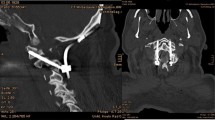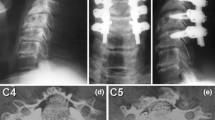Abstract
To reconstruct highly destructed unstable rheumatoid arthritis (RA) cervical lesions, the authors have been using C1/2 transarticular and cervical pedicle screw fixations. Pedicle screw fixation and C1/2 transarticular screw fixation are biomechanically superior to other fixation techniques for RA patients. However, due to severe spinal deformity and small anatomical size of the vertebra, including the lateral mass and pedicle, in the most RA cervical lesions, these screw fixation procedures are technically demanding and pose the potential risk of neurovascular injuries. The purpose of this study was to evaluate the accuracy and safety of cervical pedicle screw insertion to the deformed, fragile, and small RA spine lesions using computer-assisted image-guidance systems. A frameless, stereotactic image-guidance system that is CT-based, and optoelectronic was used for correct screw placement. A total of 21 patients (16 females, 5 males) with cervical disorders due to RA were surgically treated using the image-guidance system. Postoperative computerized tomography and plane X-ray was used to determine the accuracy of the screw placement. Neural and vascular complications associated with screw insertion and postoperative neural recovery were evaluated. Postoperative radiological evaluations revealed that only 1 (2.1%; C4) of 48 screws inserted into the cervical pedicle had perforated the vertebral artery canal more than 25% (critical breach). However, no neurovascular complications were observed. According to Ranawat’s classification, 9 patients remained the same, and 12 patients showed improvement. Instrumentation failure, loss of reduction, or nonunion was not observed at the final follow-up (average 49.5 months; range 24–96 months). In this study, the authors demonstrated that image-guidance systems could be applied safely to the cervical lesions caused by RA. Image-guidance systems are useful tools in preoperative planning and in transarticular or transpedicular screw placement in the cervical spine of RA patients.






Similar content being viewed by others
References
Abumi K, Kaneda K, Shono Y, Fujiya M (1999) One-stage posterior decompression and reconstruction of the cervical spine by using pedicle screw fixation systems. J Neurosurg (Spine 1) 90:19–26
Abumi K, Shono Y, Ito M, Taneichi H, Kotani Y, Kaneda K (2000) Complications of pedicle screw fixation in reconstructive surgery of the cervical spine. Spine 25:962–969
Amiot LP, Labelle H, DeGuise JA, Sati M, Brodeur P, Rivard CH (1995) Computer-assist pedicle screw fixation. A feasibility study Spine 20:1208–1212
Borm W, Konig RW, Albrecht A, Richter HP, Kast E (2004) Percutaneous transarticular atlantaxial screw fixation using a cannulated screw system and image guidance. Minim Invasive Neurosurg 47:111–114
Casey ATH, Crockard HA, Bland JM, Stevens J, Moskovich R, Ransford AO (1996) Surgery on the rheumatoid cervical spine for the non-ambulant myelopathic patients-too much, too late? Lancet 347:1004–1007
Clark CR (1994) Rheumatoid involvement of the cervical spine. An overview. Spine 19:2257–2258
Fuji T, Oda T, Kato Y, Fujita S, Tanaka M (2000) Accuracy of atlantoaxial transarticular screw insertion. Spine 25:1760–1764
Golfinos JG, Fitzpatrick BC, Smith LR, Spetzler RF (1995) Clinical use of a flameless stereotactic arm: results of 325 cases. J Neurosurg 83:197–205
Grob D, Crisco JJ 3rd, Panjabi MM, Wang P, Dvorak J (1992) Biomechanical evaluation of four different posterior atrantoaxial fixation techniques. Spine 17:480–490
Jones EL, Heller JG, Silcox DH, Hutton WC (1997) Cervical pedicle screws versus lateral mass screws. Anatomic feasibility and biomechanical comparison. Spine 22:977–982
Kamimura M, Ebara S, Itoh H, Tateiwa Y, Kinoshita T, Takaoka K (1999) Accurate pedicle screw insertion under control using a computer-assisted image guiding system: laboratory test and clinical study. J Orthop Sci 4:197–206
Kamimura M, Ebara S, Itoh H, Tateiwa Y, Kinoshita T, Takaoka K (2000) Safe and accurate cervical pedicle screw insertion guided by a computer assisted image-guidance system. J Spinal Disord 13:218–225
Kast E, Mohr K, Richter HP, Borm W (2006) Complication of transpedicular screw fixation in the cervical spine. Eur Spine J 15:327–334
Kotani Y, Cunningham BW, Abumi K, McAfee PC (1994) Biomechanical analysis of cervical stabilization systems: an assessment of transpedicular screw fixation in the cervical spine. Spine 17:2529–2539
Laine T, Lund T, Ylikoski M, Lohikoski J, Schlenzka D (2000) Accuracy of pedicle screw insertion with and without computer assistance: a randomized controlled clinical study in 100 consecutive patients. Eur Spine J 9:234–240
Madawi AA, Casey AT, Solanki GA, Tuite G, Veres R, Crockard HA (1997) Radiological and anatomical evaluation of the atrantoaxial transarticular screw fixation technique. J Neurosurg 86:961–968
Magerl F, Seemann PS (1987) Stable posterior fusion of the atlas and axis by transarticular screw fixation. In: Kehr P, Weidner A (eds) Cervical spine I. Springer, Berlin Heidelberg New York, pp 322–327
Nolte LP, Zamorano LJ, Jiang Z, Wang Q, Langlotz F, Berlemann U (1995) Image-guided insertion of transpedicular screws. A laboratory set-up. Spine 20:497–500
Ranawat CS, O’Leary P, Pellici P (1979) Cervical spine fusion in rheumatoid arthritis. J Bone Joint Surg 61A:1003–1010
Santavirta S, Konttinen Y, Laasonen E, Honkanen V, Antti-Poika I, Kauppi M (1991) Ten-year results of operations for rheumatoid cervical spine disorders. J Bone Joint Surg 73B:116–120
Sharp J, Purser DW, Lawrence JS (1958) Rheumatoid arthritis of the cervical spine in the adult. Ann Rheum Dis 17:303–313
Shintani A, Zervas NT (1972) Consequence of ligation of the vertebral artery. J Neurosurg 36:447–450
Smith MD, Emery SE, Dudley A, Murray KJ, Leventhal M (1993) Vertebral artery injury during anterior decompression of the cervical spine. A retrospective review of ten patients. J Bone Joint Surg 75B:410–415
Sumi M, Kataoka O, Ikeda M, Sawamura S, Uno K, Siba R (1997) Atlantoaxial dislocation: a follow-up study of surgical results. Spine 22:759–764
Sunahara N, Matsunaga S, Mori T, Ijiri K, Sakou T (1997) Clinical course of conservatively managed rheumatoid arthritis patients with myelopathy. Spine 22:2603–2608
Tumialan LM, Wippold FJ 2nd, Morgan RA (2004) Tortuous vertebral artery injury complicating anterior cervical spinal fusion in a symptomatic rheumatoid cervical spine. Spine 29:E343–E348
Wright NM, Lauryssen C (1998) Vertebral artery injury in C1–2 transarticular screw fixation: results of a survey of the AANS/CNS Association of Neurological Surgeon/Congress of Neurological Surgeons. J Neurosurg 88:634–640
Author information
Authors and Affiliations
Corresponding author
Rights and permissions
About this article
Cite this article
Takahashi, J., Shono, Y., Nakamura, I. et al. Computer-assisted screw insertion for cervical disorders in rheumatoid arthritis. Eur Spine J 16, 485–494 (2007). https://doi.org/10.1007/s00586-006-0234-5
Received:
Revised:
Accepted:
Published:
Issue Date:
DOI: https://doi.org/10.1007/s00586-006-0234-5




